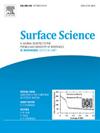用密度泛函理论研究了氧在双金属Pd3M2团簇(M = Ag、Au、Co、Cu、Mn、Ni、Pt和Ru)上的吸附
IF 2.1
4区 化学
Q3 CHEMISTRY, PHYSICAL
引用次数: 0
摘要
我们通过密度泛函理论(DFT)计算系统地研究了原子氧和分子氧在羟基化氧化铝支撑的双金属Pd3M2簇(M = Ag、Au、Co、Cu、Mn、Ni、Pt和Ru)上的吸附。计算了原子氧和分子氧与无负载Pd3M2簇之间的相互作用,并进行了比较。研究发现,在无负载和羟化氧化铝负载的情况下,氧分子在Pd3Co2、Pd3Mn2和Pd3Ru2上的吸附均自发解离。对于所有其他情况,分子氧的键长在吸附时被激活到超氧状态。Bader电荷分析表明,当转移到氧分子反键π轨道的电荷大于-1.3个电子时,氧分子自发解离。对氢化氧化铝团簇上原子氧的吸附研究表明,除了Pd3Ru2团簇外,在形成OH的所有情况下,被吸附的氧原子都自发地从底物中吸收h原子,并表现出反向h溢出。当氧原子吸附在羟基化氧化铝负载的Pd3Mn2簇上时,由于被吸附的氧原子自发地从底物上拾取了两个氢原子,形成了水分子。本文章由计算机程序翻译,如有差异,请以英文原文为准。

The adsorption of oxygen on bimetallic Pd3M2 clusters (M = Ag, Au, Co, Cu, Mn, Ni, Pt, and Ru) with and without alumina support by density functional theory
We performed density functional theory (DFT) calculations to systematically investigate the adsorption of atomic and molecular oxygen on the bimetallic Pd3M2 clusters (M = Ag, Au, Co, Cu, Mn, Ni, Pt, and Ru) supported on hydroxylated alumina. The interaction between the atomic and molecular oxygen with unsupported Pd3M2 clusters was also computed for comparison. It was found that oxygen molecule dissociates spontaneously upon adsorption on Pd3Co2, Pd3Mn2, and Pd3Ru2 for both unsupported and hydroxylated alumina-supported situations. For all other cases, the bond length of molecular oxygen is activated to a superoxo state upon adsorption. Bader charge analysis revealed that when the charge transfer to the antibonding π orbital of the oxygen molecule was greater than -1.3 electrons, the oxygen molecule dissociated spontaneously. The study of the adsorption of atomic oxygen on the hydroxylated alumina-supported clusters showed that the adsorbed oxygen atom spontaneously picks up H-atom from the substrate for all cases forming OH and representing a reverse H-spillover except for the Pd3Ru2 cluster. Water molecule is formed when atomic oxygen is adsorbed on hydroxylated alumina-supported Pd3Mn2 cluster due to the spontaneous pick up of two H-atoms from the substrate by the adsorbed atomic oxygen.
求助全文
通过发布文献求助,成功后即可免费获取论文全文。
去求助
来源期刊

Surface Science
化学-物理:凝聚态物理
CiteScore
3.30
自引率
5.30%
发文量
137
审稿时长
25 days
期刊介绍:
Surface Science is devoted to elucidating the fundamental aspects of chemistry and physics occurring at a wide range of surfaces and interfaces and to disseminating this knowledge fast. The journal welcomes a broad spectrum of topics, including but not limited to:
• model systems (e.g. in Ultra High Vacuum) under well-controlled reactive conditions
• nanoscale science and engineering, including manipulation of matter at the atomic/molecular scale and assembly phenomena
• reactivity of surfaces as related to various applied areas including heterogeneous catalysis, chemistry at electrified interfaces, and semiconductors functionalization
• phenomena at interfaces relevant to energy storage and conversion, and fuels production and utilization
• surface reactivity for environmental protection and pollution remediation
• interactions at surfaces of soft matter, including polymers and biomaterials.
Both experimental and theoretical work, including modeling, is within the scope of the journal. Work published in Surface Science reaches a wide readership, from chemistry and physics to biology and materials science and engineering, providing an excellent forum for cross-fertilization of ideas and broad dissemination of scientific discoveries.
 求助内容:
求助内容: 应助结果提醒方式:
应助结果提醒方式:


